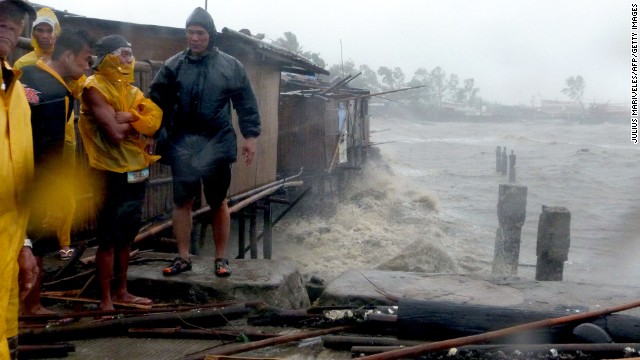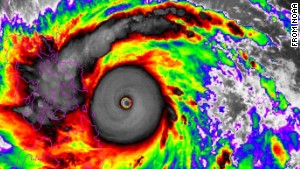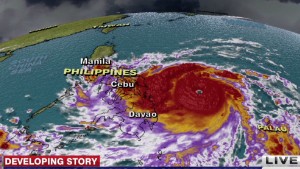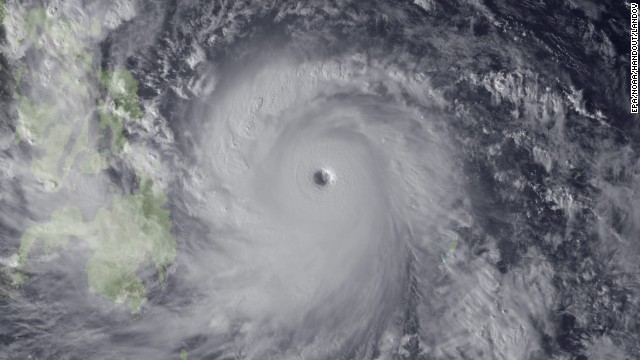The world waits to see powerful typhoon's devastation in the Philippines
(CNN) -- As dawn broke Saturday in the Philippines, the devastation of Super Typhoon Haiyan was expected to become better known a day after the storm -- perhaps the strongest ever -- rampaged across the central isles of the archipelago.
An early report by the National Disaster Risk Reduction and Management Council indicated at least three people were killed, but there were widespread fears of a much higher death toll. At least seven people were hurt, according the council's report on Friday.
The destruction is expected to be catastrophic. Storm clouds covered the entire Philippines, stretching 1,120 miles -- equal to a distance between Florida and Canada. The deadly wind field, or tropical storm force winds, covered an area the size of Montana or Germany.
The typhoon first roared onto the country's eastern island of Samar at 4:30 a.m. Friday, flooding streets and knocking out power and communications in many areas of the region of Eastern Visayas, and then continued its march, barreling into five other Philippine islands.
Then, predawn Saturday, it headed toward Vietnam.




Haiyan weakened Saturday and was no longer a super typhoon, rather a typhoon with sustained winds of 145 mph (230 kph). But the storm could return to super typhoon status Saturday. The center of Haiyan will land again Sunday morning near the Vietnamese cities of Da Nang and Hue.
Philippine military helicopters were scheduled to take aerial surveys of the damage Saturday. Relief agencies in Manila were expected to begin traveling as long as 18 hours to reach the worst hit isles. Meanwhile, Haiyan was over the South China Sea on Saturday morning.
After the storm passed over his family's home in Cebu City, Chris Ducker told CNN by phone Saturday that his family was safe, but "it's been quite a harrowing day to say the least." Part of his roof was ripped off, leaking water, he said.
When Haiyan hit Cebu City on Friday morning, it awakened Ducker.
"The first thing I noticed straightaway as soon as my eyes opened was the howling of the winds around the house," said Ducker, whose home is in the mountains with a 360-degree view.
"I've never experienced winds like this in my entire existence. I've lived in this country for 13 years and I've been through a few earthquakes, I've been through plenty of these storms. We get hit quite regularly with storms, as you probably already know. But, yes, this was something else. The rain, when I looked out of the window, the rain wasn't falling. The rain was being pushed almost at, you know, a 100-degree angle right in front of our house. It was pretty incredible," he added.
Most of the Cebu province couldn't be contacted by landlines, cell phones or radio Saturday, said Dennis Chiong, operations officer for the province's disaster risk and emergency management.
Among the early reports is how one inaccessible town, Daanbantayan, has more than 3,000 residents who "badly need food, water and shelter because most of the houses there are damaged due to the storm," Chiong said.
The town of Santa Fe in Cebu saw 20% to 30% of its residents losing their houses, but officials weren't able to determine fatalities because roads were washed out and phone service was down, information officer Marvin Camay said on the province's Facebook page.
Defenseless against the storm's might
On Bohol Island, power was still out Saturday, but cell phone coverage was restored and damaged roads were being reopened, said one relief worker.
But the big concern was how did the typhoon impact the island's 350,000 people living in tents and temporary shelters since last month's earthquake, said Joe Curry of Catholic Relief Services on Bohol.
"This one was incredibly intense and big," Curry told CNN. "The strength of this typhoon is phenomenal and the way it moved across the Philippines is something of serious concern."
He feared that the hardest hit islands will experience the most fatalities.
"Those are the ones that will have the most loss," Curry said. "There are a lot of rural areas, a lot of small islands that are affected. We don't know how they can protect themselves from a typhoon of this strength."
Clarson Fruelda, of Cebu City, said residents were cleaning up dirt, leaves, coconuts, and tree branches from their homes Friday afternoon, when the storm had passed. A CNN iReporter, she described the Filipino spirit as "waterproof."
"The winds were the strongest that I felt in more than 20 years," Fruelda told CNN. "These past few weeks were really tough for my wife and I and probably for Cebuanos as well since it was just a few weeks ago when we were hit by a 7.2 magnitude earthquake.
"We would proudly say we survived 2013 and bring it on 2014," Fruelda added.
The state-run Philippines News Agency, citing unconfirmed TV reports, said "around 20" people drowned after a storm surge struck Friday morning in Palo, a town on the island of Leyte, which abuts Samar.
"Most of the fatalities sustained massive injuries in the head and upper part of the body, indicative that strong waves dashed them against hard objects," it reported, adding that nine of the dead were minors.
Experts predicted the casualty toll would soar once aid workers get to the hardest-hit areas, many of which were totally isolated -- no phone service, no electricity.
About 125,000 people took refuge in evacuation centers, and hundreds of flights were canceled.
With sustained winds of 195 mph (315 kph) and gusts as strong as 235 mph (380 kph), Haiyan may be the strongest tropical cyclone to hit land anywhere in recorded history. It will take further analysis after the storm passes to establish whether it is a record.
The Saffir-Simpson Hurricane Wind Scaledescribes winds of 157 mph (252 kph) or higher as capable of causing catastrophic damage. "A high percentage of framed homes will be destroyed, with total roof failure and wall collapse. Fallen trees and power poles will isolate residential areas. Power outages will last for weeks to possibly months. Most of the area will be uninhabitable for weeks or months."
Haiyan was on a westward track when it raced into Samar traveling at 25 mph (41 kph), which meant the worst was over quickly. But the damage was severe. "About 90% of the infrastructure and establishments were heavily damaged," Gwendolyn Pang, the secretary general of the Philippine National Red Cross, told CNNI.
By early Saturday, the speed had dropped slightly, to 23 mph (37 kph).
Category 5 strength
About 25 areas in the Philippines were hit, Pang said, adding that assessment teams were prepared to enter the stricken areas as soon as conditions allowed.
But they cannot do it alone, she said: "We will be definitely needing more support for this one."
Floodwater was as high as 10 feet in some areas.
Maryann Zamora, a field communications specialist for the charity World Vision, said her organization "has been working through so many disasters, so many typhoons -- but this is quite different."
"This is the strongest I ever felt so far," she said by phone from the island of Cebu.
Haiyan, known in the Philippines as Yolanda, retained much of its force as it moved westward Friday with sustained winds of 295 kph (183 mph), which put it well above the 252 kph threshold for a Category 5 hurricane, the highest category on the Saffir--Simpson scale.
Video showed streets flooded with debris and sheets of metal flying through the air.
Gov. Roger Mercado of Southern Leyte, a province in Eastern Visayas near the storm's path, said Friday morning that fallen trees had made all roads impassable. "We don't know the extent of the damage," he said. "We are trying to estimate this. We are prepared, but this is really a wallop."
With sea travel suspended in many areas, more than 3,000 travelers were stranded in ports, the council said.
Meteorologists said it maintained super typhoon intensity throughout its passage over the Philippines. A super typhoon has surface winds that sustain speeds of more than 149 mph (240 kph) for at least a minute, according to the U.S. National Oceanic and Atmospheric Administration.

No comments:
Post a Comment